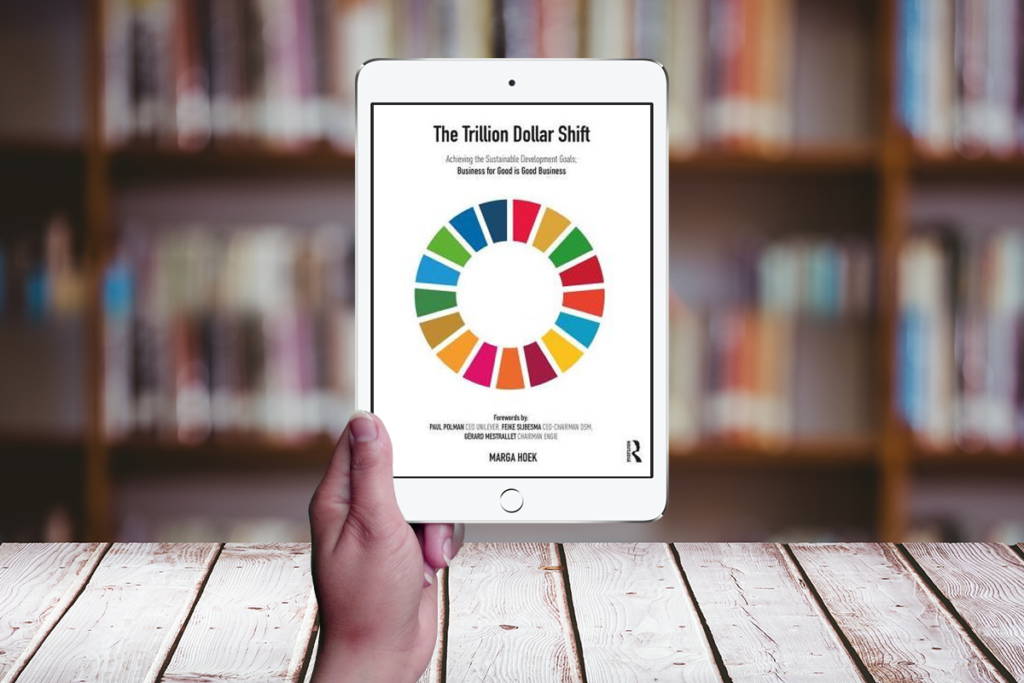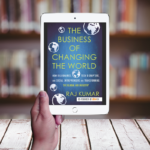The 2030 Sustainable Development Goals (SDGs), also known as the Global Goals, reflect the multiple challenges our world faces today and represent a blueprint for social, economic and environmental sustainability. Meeting these goals is expensive and requires considerable acceleration in policy support and capital mobilization from governments and the private sector. The active leadership of the latter is especially critical as current estimates of public sector support hover around only $2 trillion, relative to $30 to $45 trillion required by 2030.
But what exactly does it mean for businesses to help achieve the SDGs? To get to the bottom of this, I review Marga Hoek’s book, The Trillion Dollar Shift, which discusses how business and capital can have a positive impact on the SDGs, while also improving their competitiveness.
What does Hoek mean by trillion dollar shift?
I like the fact that Hoek’s book focuses on businesses and the SDGs. What first caught my interest however is her use of “trillion dollar shift” in the title of the book – who doesn’t want a dollar (I mean a trillion)? I wanted to know what exactly she means by that phrase and so decided to read the book. It was in the second chapter that things got clearer.
Hoek references a 2014 report by the United Nations Conference on Trade and Development and a 2017 report by the Business and Sustainable Development Commission to emphasize, respectively, the gap in SDGs funding and the market opportunities to businesses. The former estimates that achieving the SDGs will require between $5 to $7 trillion per year across the developed and developing world. The latter projects that the SDGs could open up about $12 trillion of market opportunities across four economic systems of food and agriculture, cities, energy and materials, and health and wellbeing.
As encouraging as the SDG business opportunities might be, corporations, by virtue of their drive to increase shareholder value, tend to be apprehensive that aligning their operations with the SDGs could pose a threat to perpetual growth. Hoek offers some interesting perspectives on this in the remainder of her book. Below, I emphasize four of her key themes that I find compelling in the book.
Theme #1: Businesses have contributed to our problems and are central to the solution
Businesses are, in part, to blame for the mass destruction of our natural resources
Hoek reports that the adoption of the SDGs is a request for action by governments and a message from and for the business and capital world. She acknowledges, though briefly, that businesses are, in part, to blame for the mass destruction of our natural resources. Although Hoek provides few details on the extent of damage that corporations inflict (or have inflicted) on the environment, I did some research and found that literature on the subject is extensive (Rowlands, 2001; Silva et al., 2016; Blomsma and Brennan, 2017; Daudigeos et al., 2018). Negative environmental impacts of corporations broadly take two forms – they consume much of the earth’s resources and dump large quantities of waste into the environment.
To put this into perspective, the largest 500 transnational corporations are responsible for more than half of the greenhouse gas emissions produced annually and just 100 companies (including Shell, BP, ExxonMobil and Chevron) have been responsible for about 71% of the world’s greenhouse gases since 1988, according to a recent report by the Carbon Disclosure Project.
Businesses can use their power and scale to drive innovative solutions
Theme #2: Corporate social responsibility is good but not so good for SDGs
What is shared value and corporate social responsibility?
Hoek touches on the concepts of creating social value (also known as shared value) and corporate social responsibility and explains why she feels the former supersedes the latter and represents the best approach to articulate a business case for the SDGs. Her definition of creating social value is based on the work of pioneering researchers and business strategists, Michael Porter and Mark Kramer, who define the concept as corporate “policies and operating practices that enhance the competitive advantage of a company while simultaneously advancing the economic and social conditions in the communities in which it operates” (p. 60). Corporate social responsibility on the other hand emphasizes a “vision of business accountability to a wide range of stakeholders, not only shareholders and investors” (p. 64). Key areas of concern are environmental protection and the wellbeing of employees, the community and civil society in general.
A shared value approach is better but has its own shortcomings
Hoek makes it clear that corporate social responsibility is unquestionably a course in the right direction, but argues the concept is not rooted in the fabric of the financial model for profit. The concept’s common strategy is that a company maximizes shareholder value, then uses some of those profits for social good. Her source of worry is the first part of maximizing shareholder value which often brings a certain level of harm to the environment, the suppliers and customers, and the local communities. The reason she thinks shared value is better is that it focuses on creating measurable business value and involves businesses taking advantage of the opportunities in social problems.
While Hoek’s arguments in favor of creating social value are legitimate and emphasize how the concept connects business and society in a more integrated and holistic way, I feel it would have been useful if Hoek highlighted opposing perspectives on creating shared value. For instance, there are concerns that it does not question the underlying premises behind legacy businesses (Reyes and Scholz, 2019). It also promotes corporate cherry-picking and makes it possible for companies to focus on the easy wins, while leaving unresolved the deeper environmental and socio-economic issues to which they are connected (Crane et al., 2014 [gated]). Clearly, addressing these criticisms would be useful in helping businesses use a shared value approach to effectively maximize their contributions to the SDGs.
Theme #3: Strategic SDG alignment is a great business opportunity
What is SDG alignment?
Why is SDG alignment a great business opportunity?
In most parts of her book, Hoek makes a strong case for why she thinks aligning with the SDGs is a great business opportunity. In chapter nine for example, she argues that the potential payoff of circular economy models, renewable energy, energy efficiency and energy access is around $4.3 trillion by 2030. By circular economy, she means “a restorative and regenerative system where all products are designed and marketed with reuse and recycling in mind” (p. 387). The benefits of such a system, she argues, include significant drops in use of virgin materials, reductions in materials waste as products are designed to last, and utilization of manufacturing by-products and excess materials previously considered waste streams.
Other research confirms Hoek’s take on SDG alignment
Hoek’s argument is consistent with research by other agencies that I found. For instance, McKinsey’s 2017 report on mapping the benefits of a circular economy shows that circular economy models in Europe alone, could boost resource productivity by 3% by 2030, equivalent to cost savings of €600 billion a year and €1.8 trillion more in other economic benefits. In another report by the International Renewable Energy Agency, it is projected that a significant shift to electricity generation from renewable sources can deliver 60% of the 75% CO2 emissions reduction expected from energy-related activities by 2050. Factoring in renewables for heating and transport would lead to a further reduction of 75%, and ramping up energy efficiency investments can reduce emissions even more by 90%.
Certainly, this is good for not only the environment but also for businesses. According to IGS, investments in energy efficiency for instance, can reduce running costs for businesses, lower their carbon footprint, increase the market value of energy-efficient buildings and improve brand image with consumers and the public.
Theme #4: Business benefits of strategic SDG alignment is tremendous
Throughout the book, Hoek presents case studies of businesses – large, medium and small – that have aligned their business models to the SDGs. Here, I highlight a few of them.
Enel shows that SDG alignment can increase share price
Through an initiative called Enabling Electricity, Hoek reports that Enel (p. 66) is committed to addressing energy poverty, protecting the environment and local communities in Africa, Asia and Latin America. By the end of 2016, Enel’s net income, as a result of this, reached €2.6 billion compared to €2.2 billion in the year prior. Not only that, its share price also increased by 8% to 12% in 2016.
Nike shows embracing sustainability can generate large profits
Hoek also discusses how the sportswear giant, Nike (p. 86), now boasts some of the highest returns on sustainable investments in the North American apparel and footwear space as a result of its strategic decision to embed sustainability into its innovation process. Its $1 billion Flyknit line has led to the reduction of 3.5 million pounds of waste while also generating large profit margin. By cutting down energy use per footwear by half, Hoek reports that Nike shipped over a billion units of footwear and saw its sales rise 52% between fiscal years 2011 and 2015.
Toshiba shows conserving resources is possible
Additionally, Hoek provides another striking example of Toshiba (p. 388), a Japanese multinational conglomerate and a global leader in office printing and retail solutions. She describes the company’s business model and commitment to ensuring that the products it produces do not negatively impact the environment. Through its Environmental Action Plan, the company commits to increasing the amount of resources conserved to 1.5 times the 2010 level. In 2015, its major products used resources 30% less than previous product models.
My key takeaways
Creating shared value is a solid approach but is it effective?
I like the introduction of the concepts of shared value and corporate social responsibility and how Hoek argues that the former, unlike the latter, contributes to not only economic gains and business competitiveness but also positive environmental and societal impacts. I agree that creating shared value is a solid approach through which businesses can contribute to the realization of the SDGs. What I felt Hoek could have offered more insights on is perhaps the contention surrounding the effectiveness of shared value approaches and how businesses can overcome such challenges in their efforts to contribute to the SDGs.
Hoek’s case studies are unique and diverse
I feel that Hoek’s presentation of case studies across different countries, touching on each of the 17 SDGs, was unique. What these set of cases suggest is that, whatever the sector, industry, region or country a company operates in, there are myriad opportunities to align business strategies to the global goals. Hoek’s emphasis on the important role of all businesses, large, medium or small, is very useful. A vast majority of private sector businesses across the globe are small-and medium-sized enterprises. The active involvement of these “small players” in the SDGs is thus critical.
The case studies sometimes lack information to describe the benefit to the business
While Hoek’s meticulous presentation of case studies across different countries and industries is great, I feel that some of the cases lack enough information to assess the effectiveness of businesses’ respective SDG strategies. I will give some examples. In the case of Interface (p. 58) for instance, Hoek reports that the company’s Mission Zero initiative has helped it reduce greenhouse gas emissions by 95%, obtain 87% of its energy from renewable sources and produce its products with about 58% recycled and bio-based materials. What the case study does not mention is how much these benefits are worth in terms of cost savings and revenue gains.
The Toshiba case is also a good example. According to Hoek, the company is very sensitive about the impacts that its production activities have on the environment. Consequently, Toshiba takes responsibility for the entire life-cycle of its products and operates stringent procurement guidelines that truly consider the circular life of a product. While this information gives us an idea about how environmentally sustainable Toshiba is, it does not say much about the economic benefits to the company.
Are those benefits solely due to SDG alignment?
As evident in many chapters of the book, I agree that effectively aligning corporate strategies with the SDGs can bring value across different business domains – investors, customers, employees and community stakeholders. The SDGs are 17 for a reason. There are abundant opportunities for every business, in any region across any sector to visualize itself on the 2030 Global agenda.
Photo credit: FHI 360



